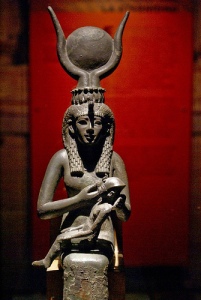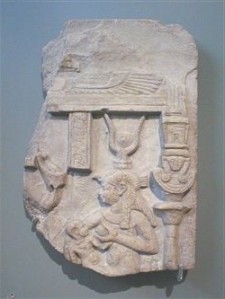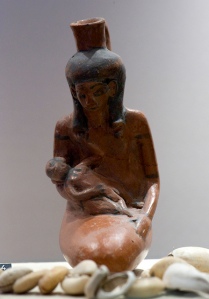Lately, I am thinking about the stars.
With our hot weather, the night skies are clear now, so when I look up, I can see the body of beautiful, star-filled Nuet, the mother of Isis. A little while ago, a friend of this blog asked a very interesting question about Her…and Her. “How we can reconcile the idea that Isis is both Mother of All with the idea that Isis has a mother Herself,” they asked.
It’s a very interesting question because it has to do with our conception of the nature of the Divine and Divine Beings in general.
So how do we start to look at this?
For me, history is always a good place to begin. It gives us a useful foothold to know what our ancestors thought about these things; after all, when it comes to Divinity and Divine Beings, we human beings have been thinking about this for a very long time indeed.
Erik Hornung’s Conceptions of God in Ancient Egypt, the One and the Many is one key text for understanding the nature of the Divine in terms of ancient Egypt. Hornung writes that the Egyptians had a multiplicity of approaches to the Divine and only when taken together can we see the whole picture. For them, he says, everything came from One because the non-existent is One, Undifferentiated Thing. Once something becomes existent, it also becomes multiple.
We see this in the Heliopolitan myth in which Atum comes forth from the Nun, the non-existent, the inert, and immediately begins generating other Deities through an act of masturbation: first Shu and Tefnut, Who beget Nuet and Geb, Who beget Isis, Osiris, Set, and Nephthys.
And so we meet Isis, Her mother Nuet, and Her mother’s mother Tefnut. And there may even be a great grandmother present, for when Atum came into existence, He was both masculine and feminine; His “shadow” or “hand” (the one He used to masturbate) is the Goddess Iusaaset or Iusâas. She is usually represented anthropomorphically, through, and not as a disembodied hand, and She is said to be the Grandmother of All the Gods.
Another important characteristic of the Divine in ancient Egypt is Its fluidity. Hornung says of the Egyptian Deities, “They are formulas rather than forms, and in their world, one is sometimes as if displaced into the world of elementary particles.” Deities may be combined with one another or split off from one another; one Deity can be the ba—soul or manifestation—of another; They can even be assimilated with foreign Deities without losing Their essence. “But wherever one turns to the divine in worship, addresses it and tends to it in cult” Hornung writes, “it appears as a single, well-defined figure that can for a moment unite all divinity within itself and does not share it with any other god.”
The primordiality and uniqueness of Isis is attested on the Great Pylon of Her graceful temple at Philæ. The Ptolemaic passage states that Isis “is the one who was in the beginning; the one who first came into existence on earth.” In the Coffin Texts, Isis is invoked with a group of Deities considered to be the most ancient: “O Re, Atum, Nu, Old One, Isis the Divine…” (Formula 1140). She is called Great Goddess Existing from the Beginning, Great One Who Initiated Existence, and Great One Who Is From the Beginning. Her very name, Iset or Throne, speaks to Her ancient nature.
By the time of the New Kingdom, Isis is routinely called Mother of All the Gods. Then, with Her worship spreading throughout the Mediterranean and beyond, Apuleius can write that Isis “brings the sweet love of a mother to the trials of the unfortunate,” while a Latin dedicatory inscription sums up Her all-encompassing nature: Tibi, Una Quae es Omnia, Dea Isis, “Thou, Being One, Art All, Goddess Isis.”
So now we have ancient attestations both of Isis’ ancient and original one-ness and of Her generation from Her parents, grandparents, and great grandparents. How do we resolve it?
If we are among those who are uncomfortable with paradox, I’m afraid there may be no satisfying reconciliation between these two ideas. If it has been deeply ingrained that there can only be one right answer—especially when it comes to spiritual questions—then it may seem impossible for both these things to be true. After all, they contradict each other. At the very least, we should be able to pick one as the “right” answer. At the very most, we may decide the contradiction means both things must be false.
And yet we have already seen that, at least to the ancient worshipers of Isis, both things were indeed true.
This is what paradox is; and religion is absolutely rife with it. Why? Because most religions, or spiritualities, involve Mystery. Mystery is at the very core of the Divine and paradox is one of Its favorite languages. Yet this is not to say we should simply throw up our hands up and say, “Goddess works in mysterious ways” and quit thinking about it.
Quite the opposite in fact. Paradox invites thought. It is intended to teach. So what can we learn from our paradox: Isis is Mother of All, yet She Herself has a mother…and a mother’s mother…and?

Let’s look at it through that ancient Egyptian lens that shows us a multiplicity of approaches to the Divine.
One way we can approach is through the Heliopolitan myth does: Isis is part of a Divine family. By being so, perhaps She is better able to understand human beings when we come to Her with our own familial problems. Her family relations make Her more suited to be a Soteira, a Savior Goddess, as She was known throughout the Mediterranean world.
We can also learn some important things about Isis through Her family relations. Isis is the daughter of Heaven (Nuet) and Earth (Geb). She is married to the Underworld God, Osiris, and is Herself a Goddess of the Underworld. Thus Isis is intimately connected to All That Is; She walks in all the Worlds.
Another approach to our paradox is through the fluidity of the Egyptian Deities that we talked about. If They can combine or split at will, or if one can become the ba of another, why can’t Isis be at once a Great Mother Herself and the daughter of a Great Mother?
Yet another approach is to open our hearts toward Isis in worship and experience Her for ourselves. Then, as Erik Hornung explained, Isis “appears as a single, well-defined figure that can for a moment unite all divinity” within Herself; She is the One Who is All, and She is the Mother of All.
By combining these approaches, and tolerating a little paradox, we learn more about Isis than we ever would have by restricting ourselves to a single position alone and Isis reveals Herself ever more as the Great Goddess She is.
























